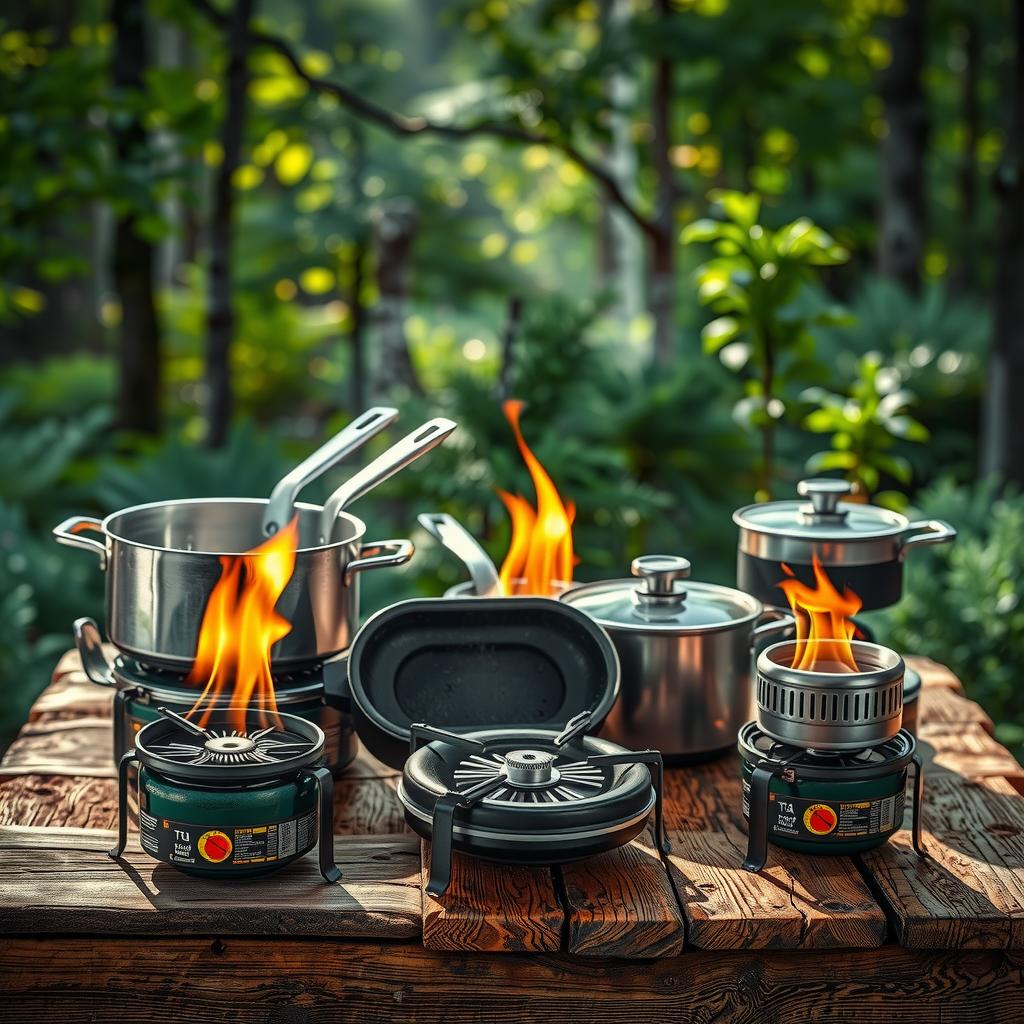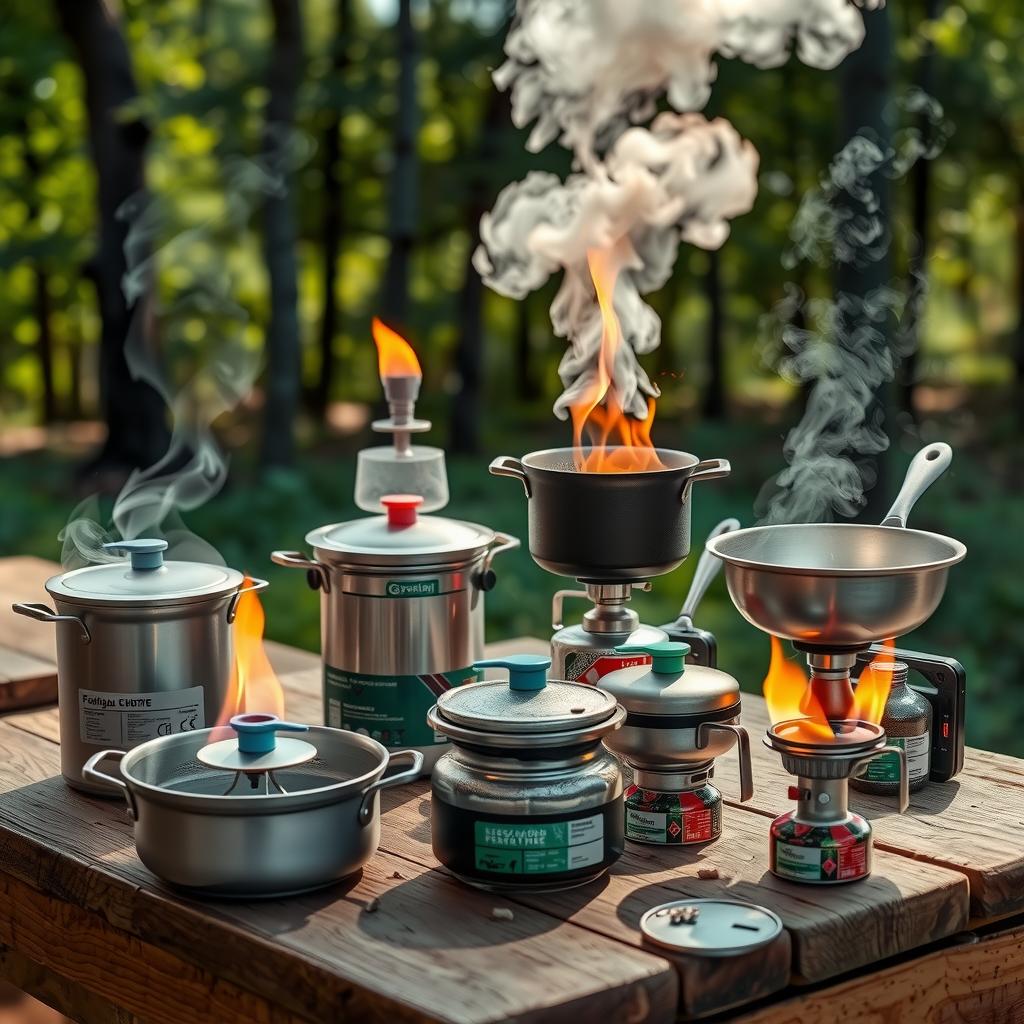When it comes to enjoying the great outdoors, one of the essential elements for a successful camping trip is efficient cooking. Many campers face a common dilemma: choosing the right Portable Camping Gas Stoves that not only fit their needs but also deliver optimal performance. With various options available in terms of BTU output, selecting the best gas stove can significantly impact cooking times and overall meal preparation efficiency. As outdoor enthusiasts know, having reliable camping gear is crucial for transforming an ordinary campsite into a culinary haven.
As campers venture into remote areas where traditional cooking methods may not be feasible, understanding the significance of BTU (British Thermal Unit) output becomes vital. This measurement indicates how much heat energy a stove can produce and directly correlates with its ability to efficiently cook food or boil water in diverse weather conditions. The core value of this article lies in providing readers with an insightful comparison of Portable Camping Gas Stoves, focusing specifically on their BTU outputs and how these ratings influence outdoor cooking experiences.
What makes this comparison particularly valuable is its focus on lightweight stoves designed for portability without sacrificing performance. For those who prioritize campfire meals yet desire quick and easy setups, knowing which gas stove offers superior heating capabilities can simplify decision-making when shopping for camping essentials. By examining various models through this lens, individuals will gain clarity on what to look for in their next portable fuel source.
This exploration will not only highlight key differences between popular models but also guide readers towards making informed choices based on their specific camping needs and preferences. Whether someone is planning a weekend getaway or embarking on an extended hiking expedition, understanding BTU output helps ensure that each meal prepared over a portable camping stove meets expectations while enhancing overall enjoyment during outdoor adventures.
In essence, this article serves as both an informative resource and practical guide aimed at helping avid campers navigate the world of Portable Camping Gas Stoves. With careful analysis of each option’s strengths regarding BTU output and cooking efficiency, readers will be equipped with knowledge to elevate their outdoor cooking experience like never before—making every bite worth savoring under the stars.

Key Points:
-
Understanding BTU Output: A critical factor in choosing the right portable camping stove. The BTU rating determines how quickly and efficiently a stove can cook meals, influencing decisions based on cooking needs.
-
Cooking Efficiency Considerations: Examining how different models of Portable Camping Gas Stoves manage fuel consumption and heat distribution provides insights into their effectiveness for various outdoor cooking scenarios.
-
Variety of Models Available: With numerous options in the market, campers must assess features such as size, weight, and BTU output to select the best fit for their specific culinary adventures while enjoying nature.

Understanding BTU Ratings in Portable Camping Stoves
Decoding the Role of BTU in Your Outdoor Cooking Experience
When it comes to outdoor cooking with Portable Camping Gas Stoves, understanding BTU ratings is crucial for achieving optimal cooking performance. The term “BTU,” which stands for British Thermal Unit, essentially measures the energy output of a stove and indicates how much heat it can produce within an hour. This metric becomes particularly important when comparing different models of lightweight stoves intended for camping gear. For example, a stove with higher BTU output will generally cook food faster and more efficiently than one with lower ratings, making it a vital factor to consider when selecting your portable fuel source.
A common misconception is that higher BTUs always equate to better performance; however, this isn’t necessarily true across all scenarios. For instance, if one is preparing delicate dishes such as sautéed vegetables or simmering sauces during outdoor cooking adventures, a stove with moderate BTUs may provide greater control over low-heat cooking compared to high-output alternatives. It’s essential to find a balance based on individual cooking needs—especially since many campers prioritize weight and portability among their camping essentials.
For gas stove comparison purposes, it’s worth noting that not only do various brands offer differing outputs measured in BTUs but also their design influences overall efficiency and usability. High-efficiency burners designed into Portable Camping Gas Stoves can enhance the effectiveness of lower-BTU units by focusing heat directly onto cookware rather than dispersing it around the surrounding area—a feature that’s especially useful in windy conditions typical at campsites.
Moreover, while reviewing options for portable camping stoves, enthusiasts should assess how well each model adapts its heating capabilities based on weather conditions or varying types of cookware utilized during trips. Factors like windshields integrated into lightweight designs are beneficial because they help retain heat generated from flames even when using stoves rated at 8,000–10,000 BTUs versus those exceeding 15,000 or more.
Ultimately, choosing the right Portable Camping Gas Stove requires careful consideration beyond mere numbers attached to potential purchases; users must reflect on their personal preferences regarding meal preparation styles and desired outcomes while out enjoying nature’s beauty. Adequate research through side-by-side comparisons will ensure newfound campers invest wisely in equipment that caters specifically to both culinary ambitions and practical preferences without sacrificing quality or convenience on their next adventure into the great outdoors.
Efficiency vs. Portability: The Key to Outdoor Cooking Success
Evaluating the Balance Between Power and Practicality in Cooking Gear
When embarking on a camping trip, choosing the right cooking equipment can be fundamental to both meal preparation and overall outdoor experience. Portable Camping Gas Stoves have emerged as popular choices for campers due to their ability to deliver high BTU outputs while maintaining portability. In this comparative analysis, various models of portable camping stoves are scrutinized, focusing on their efficiency in fuel consumption and suitability for diverse cooking styles. Typically, these stoves boast BTU outputs ranging from 5,000 to over 20,000 BTUs per hour; higher outputs are ideal for boiling water quickly or searing meats efficiently during outdoor cooking sessions. For instance, a model with an output of 15,000 BTUs may be perfect for those who prioritize rapid meal preparation without compromising food quality.
Fuel consumption is another critical metric when selecting a portable camping stove since it directly affects how long one can cook before needing additional supplies—an important consideration when planning meals away from home. Models using propane tend to offer superior efficiency compared to other fuel types like butane or alcohol-based options; thus making them viable choices for extended trips where re-supplying might pose challenges. Additionally, lightweight construction is essential not only for easy transport but also because it enhances usability across different settings—from picnics at local parks to backwoods expeditions requiring compact gear that doesn’t weigh down one’s pack.
Cooking Styles Matter: Tailoring Your Stove Choice
Adapting Portable Solutions Based on Culinary Needs
The versatility of Portable Camping Gas Stoves extends beyond mere convenience; they cater specifically to varied culinary techniques that outdoors enthusiasts employ while preparing meals in nature. Whether one desires the simplicity of boiling water or seeks more complex methods such as sautéing vegetables or grilling meats over open flames—the choice of gas stove plays an instrumental role in achieving optimal results outdoors. As such models designed explicitly with multi-functionality tend towards higher popularity among consumers looking for comprehensive solutions within their camping gear arsenal.
For example, certain lightweight stoves come equipped with features such as simmer controls which allow users greater flexibility in managing heat levels—a necessary component when trying delicate dishes like sauces or stews that require careful attention during cooking processes outside traditional kitchens. Furthermore, some stoves incorporate windshields aimed at protecting flames from adverse weather conditions—a crucial aspect given unpredictable environmental elements often encountered during outdoor adventures.
In conclusion, understanding the balance between efficiency and portability is vital when evaluating portable camping stoves on the market today—especially considering variations in BTU output and fuel consumption align closely with individual preferences regarding cooking styles used during excursions into nature’s embrace.
Maximizing Cooking Performance
Enhance Your Outdoor Culinary Experience
When embarking on an outdoor cooking adventure, maximizing heat distribution and optimizing fuel usage are essential for achieving culinary success. Utilizing Portable Camping Gas Stoves can significantly enhance this experience due to their efficient design and versatility. When comparing different types of gas stoves, it becomes evident that those with higher BTU output can produce more intense heat, which is ideal for searing meats or boiling water quickly. In contrast, lightweight stoves equipped with lower BTU capabilities may be better suited for simmering sauces or preparing delicate dishes. Understanding the balance between these options allows campers to select the best camping gear tailored to their specific cooking needs.
Furthermore, effective heat distribution plays a crucial role in outdoor cooking efficiency. Many Portable Camping Gas Stoves feature adjustable burners that enable precise temperature control; this capability helps prevent hotspots and ensures even cooking across all food items. For example, a burner set at medium-low can allow a pot of chili to cook gently without burning while retaining moisture—a critical aspect when preparing meals outdoors where ingredients might be limited and preserving flavors is paramount. Additionally, utilizing pots and pans designed specifically for camping—such as those made from aluminum or titanium—can further optimize heat conduction due to their lightweight properties.
Moreover, being mindful of fuel usage enhances not just performance but also sustainability during outdoor excursions. By choosing portable fuel sources such as propane cartridges compatible with Portable Camping Gas Stoves, users reduce the need for bulky fuel tanks while still enjoying sufficient energy output for extended meal preparation sessions. It’s advisable to pack extra cartridges based on group size and expected cooking duration; careful planning in this regard allows adventurers to enjoy uninterrupted culinary experiences without worrying about running low on fuel amid nature’s splendor.
Safety First: Best Practices in Outdoor Cooking
Safety should always remain at the forefront when engaging in outdoor culinary activities using portable equipment like gas stoves. It’s vital that users familiarize themselves with proper handling techniques before igniting any flame outdoors—this includes maintaining a safe distance from flammable materials and ensuring adequate ventilation if used within tents or confined spaces (though generally discouraged). Furthermore, keeping basic safety gear—like fire extinguishers or sand buckets—readily accessible adds an essential layer of precaution against unforeseen mishaps while enjoying nature’s beauty through food preparation.
In conclusion, by leveraging high-quality Portable Camping Gas Stoves, understanding your stove’s capabilities regarding BTU output versus intended use cases along with employing sound safety practices contribute immensely toward an unforgettable outdoor dining experience filled with delicious meals shared among friends under open skies!
Frequently Asked Questions:
Q: What should I consider when choosing a portable camping stove?
A: When selecting a portable camping gas stove, it’s essential to evaluate factors such as BTU output, weight, and cooking efficiency. Higher BTU ratings indicate quicker boiling times and greater heat for cooking, while lower outputs may be better suited for simmering or slow-cooking. Additionally, the overall weight of the stove can significantly affect your backpacking experience.
Q: How does BTU output impact outdoor cooking?
A: The BTU output directly influences how effectively a portable camping stove can perform in various cooking scenarios. Stoves with higher BTUs are ideal for tasks that require high heat like boiling water or frying food rapidly. Conversely, stoves with moderate to low BTU outputs excel at tasks requiring more control over the flame, making them suitable for preparing delicate dishes during your outdoor adventures.
Q: Are lightweight stoves less efficient than heavier models?
A: Not necessarily; many modern lightweight stoves are designed to optimize fuel consumption while maintaining excellent performance levels. The key lies in understanding each model’s specifications through gas stove comparisons. By examining their respective cooking efficiencies and features based on BTU output, campers can find options that balance portability with effective meal preparation without sacrificing quality or convenience in their camping gear.

